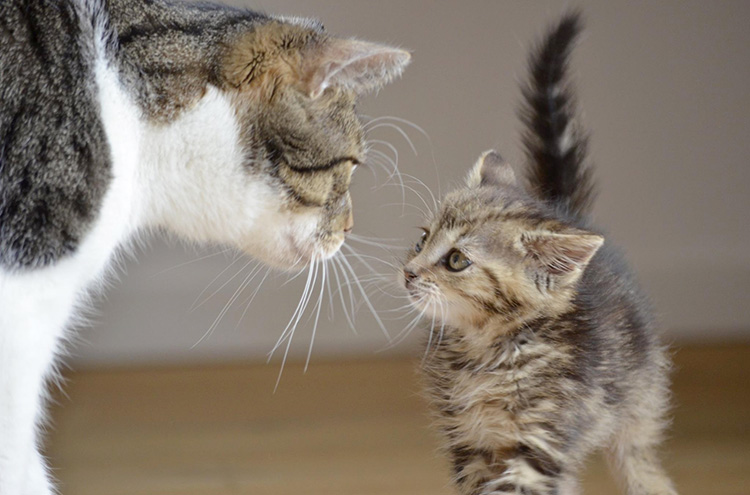Cats are solitary but can form friendships, here's our tips for helping that feline friendship blossom.
Cats don't necessarily feel the need for a feline companion the way other more social animals do. However they are capable of forming friendships with their own kind, and here are a few things you can do to help start that friendship on the right foot (or paw).
Choosing the right cat to be a friend
• A kitten is less of a threat to an existing adult cat.
• However playful kittens may be stressful for older cats who like peace and quiet, we can help you match their temperaments.
• Please consider that if your cat is used to living alone they may not like another cat in their space.
Preparing your home before adoption
Set up an area for your new cat away from your existing pet – a spare room is ideal. It is best to choose an area that your existing cat does not use very much. Ensure this area contains everything your cat will need – a bed, food and water, scratching post and a litter tray.
Install Feliway Friends diffusers in your home one or two days before you bring your new cat home – ideally one in the area set aside for your new cat and one in the main area of the house. The Feliway Friends contains pheromones specifically linked to cat bonding.
Check that there are plenty of high places that a cat can easily access. Cats naturally like to rest and hide in high areas, especially if they feel worried.
Stock up on key items. Cats naturally find it difficult to share important resources such as food, sleeping areas and places to toilet, even if they are good friends. To make your home an harmonious place provide several feeding areas, places to drink, hide and sleep and always ensure that there is more than one area to go to the toilet privately. Generally the rule is one toileting area per cat, plus one more. If cats feel that there is a plentiful supply of these things, it can help prevent any problems developing.
Scent is important
Scent is the most important of the cat's senses for communication. You can start communication between your cats even before you bring your new cat home by exchanging bedding between the cats – ask your Rehomer to assist you.
When you bring your new cat home, avoid the temptation to bother them too much, and just let them settle into their assigned space for a few days or a week. During this time, keep the cats in separate areas, but allow each cat to investigate the other's room and bed without actually meeting.
Do some 'scent swapping'. To do this, stroke each cat (separately!) without washing your hands to mix scents and swap bedding regularly. Also gather scent from the new cat's head and cheeks by gently stroking with a soft cloth and dabbing this around your home and furniture to mix with your existing cats scent.
Initial Introductions
If you introduce cats too quickly they can feel threatened and scared, which increases the chance of aggression. Once cats react like this it can be very difficult to change their perception of each other. A slow and careful introduction should lead to your cats co-existing peacefully together. gradual reduction in fearful behaviour and the cats should start to become more familiar with each other's presence.
As things progress in the right direction, you can open up the rest of the house. The time it takes to reach this stage depends on the individual cats – with some it might only take a few days, whereas others may take several weeks or months. During this time, both cats should still have their individual areas that they can access easily.

Introducing small kittens to a cat
Pop the kitten into a dog crate, putting a blanket over one side which will help the kitten feel safe and allow the adult cat to approach. Take care not to overwhelm either the kitten or your existing cat and take regular breaks.
Frightened or aggressive body language to look for
• Hissing
• Growling
• Swiping with paw
• Spitting
• Tail lashing from side to side
• Body low to the floor but with ears relaxed